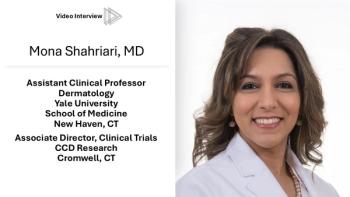
Shahriari, assistant clinical professor of dermatology at Yale University School of Medicine, says greater understanding of the condition has expanded the population for the diagnosis.

Shahriari, assistant clinical professor of dermatology at Yale University School of Medicine, says greater understanding of the condition has expanded the population for the diagnosis.

Not all atopic dermatitis requires treatment by a specialist, says this dermatologist, and she collaborates regularly with her primary care colleagues.

Tips cover biologic agents and hepatitis B, 5-FU plus calcipotriene for AK, a triple treatment package for post-acne postinflammatory hyperpigmentation, and more.

Neal Bhatia, MD, highlighted updates in the management of actinic keratosis, emphasizing strategies to reduce skin cancer risk and improve patient outcomes.

Cheri Frey, MD, explored novel active ingredients, advancements in skin care formulations at the Midwinter Clinical Derm Conference.

The sudden appearance of "a black nail" can frighten a patient and should be investigated. Nail expert Boni Elewski, MD, shares 3 cases and the outcomes.

Susan C Taylor, MD, is internationally recognized for her expertise in dermatologic conditions in skin of color and spoke about avoiding photodamage at the Midwinter Clinical Derm Conference.

Established therapies for these common disorders don't always lead to optimal results; experts offer new evidence-based options that may help.

Systemic therapy for nail disorders, including biologics and JAK inhibitors, is gaining favor; learn more about early diagnosis and aggressive treatment from an expert.

Theodore Rosen, MD, underscored the critical need for responsible antibiotic use in dermatology to combat the accelerating crisis of drug-resistant infections.

Insights into managing molluscum contagiosum, HPV-related warts, and other infections took center stage at the Midwinter Clinical Hawaii Derm Conference.

How to treat lichenoid dermatoses, what to do when the Quant Gold is indeterminate, pocket-sized Wood lights, plus 9 more pearls from the experts.

From new biologics for AD to JAK inhibitors for children with alopecia areata, get the latest updates in pediatric dermatology, here.

Switching biologic treatment for patients with moderate to severe psoriasis, needn't be daunting, Vender said; he works through a tricky case that ended very well.

Dermatology experts share pearls to help when biologics alone are not enough, when obesity is a comorbidity with psoriasis, and when isotype switching derails therapy.

Insights include new data on combination therapies, topical antiandrogens, and innovative retinoid formulations.

JAK inhibitors are being used widely and successfully to treat alopecia areata, and Amy McMichaels, MD, showcased data and also discussed patient communication.

There really is no debate - it's all about individualizing treatment for the patient, but Drs Neal Bhatia and Raj Chovatiya went head to head at Midwinter Hawaii.

April Armstrong, MD, discussed the latest data on apremilast, deucravacitinib, and emerging TYK2 and IL-23 inhibitors at Midwinter Hawaii.

The dermatologic tips offered in this short slide show come from 4 renowned professionals and reflect their subspecialties.

The 2025 Winter Clinical Hawaii kicks off today with the first full day of educational sessions starting tomorrow, February 15 - here's what to look for.

The Winter Clinical Hawaii Dermatology Conference will kick off on the Big Island on February 14th. Check out the agenda and the option to attend virtually.

The new nonsteroidal topical treatments for atopic dermatitis are targeted and modify the disease process, explains thought leader Shahriari in this year's video series.

They are a Janus kinase (JAK)1/JAK2 inhibitor, a phosphodiesterase-4 inhibitor, and an investigational aryl hydrocarbon receptor agonist. Learn more about each.

Shahriari, assistant clinical professor of dermatology at Yale University School of Medicine, says greater understanding of the condition has expanded the population for the diagnosis.